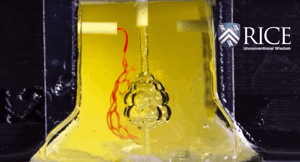As explained in the video accompanying the article, the researchers developed “stereo-lithographic apparatus for tissue engineering” (a technical name abbreviated to SLATE), capable of depositing layer upon layer of a biogel that becomes a solid when exposed to a specific blue light. Each layer of biogel (i.e. a gel containing biological material) solidifies individually, with a precision of up to a few tenths of a thousandth of a millimeter. Only once the first layer has solidified is the next layer applied, and all of this makes it possible to reconstruct an intricate architecture in a matter of minutes, similar to the real architecture of vascular networks, with a precision that had never been achieved by previous techniques.
During several preliminary tests, the researchers reconstructed a model that mimicked the lung, and managed to make red blood cells and air circulate between the new cells without any overheating and oxygen peaks (which always occurred with organoids obtained using other systems), proving the “fidelity” of the artificial tissue to the original one. In other experiments, the US researchers reconstructed liver tissue, known for its complexity, and implanted it into laboratory animals, demonstrating that it continued to be alive.
The possible applications – if other studies confirm the reliability of this technique – are many: not only the reconstruction of cardiac valves, for example, but also, as we have said, entire organs. And so (it is hoped), patients waiting for a transplant will no longer have to wait for an organ to become available, but rather one from a 3D printer with a blue light.

